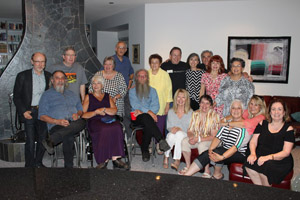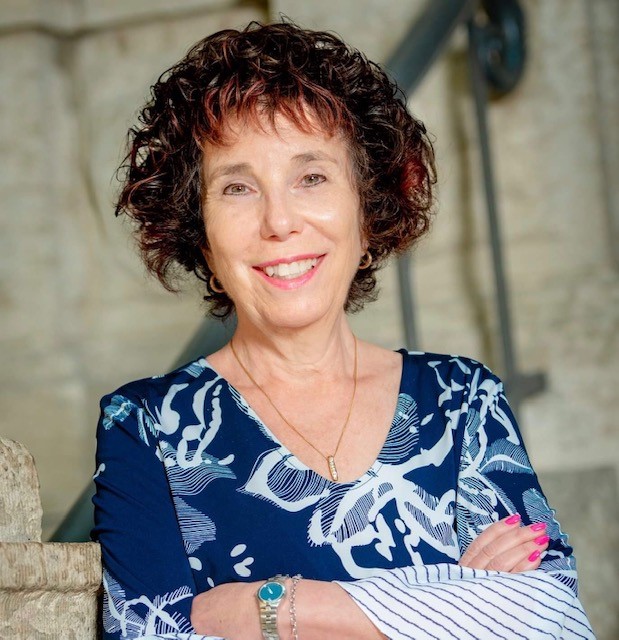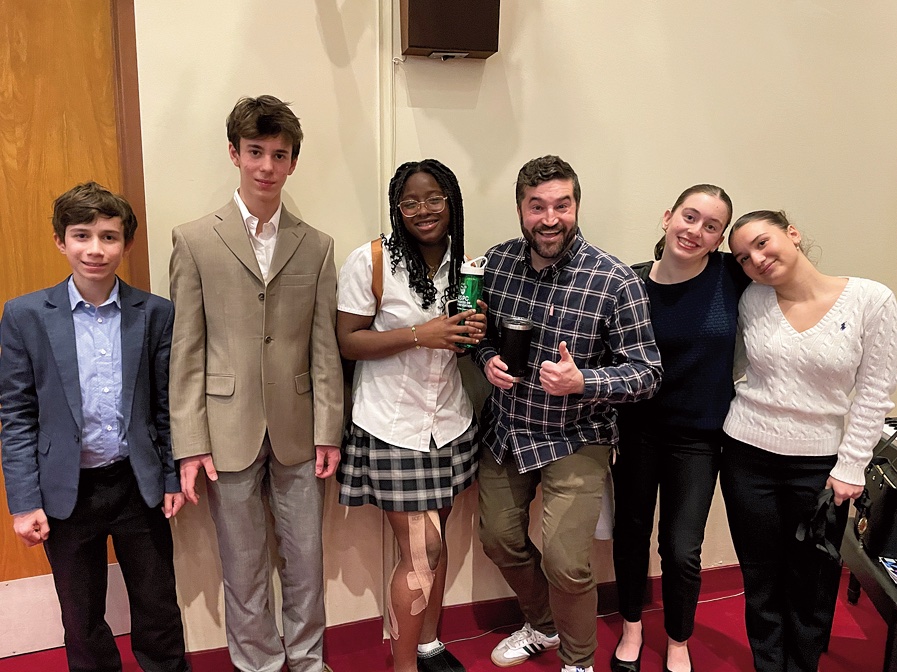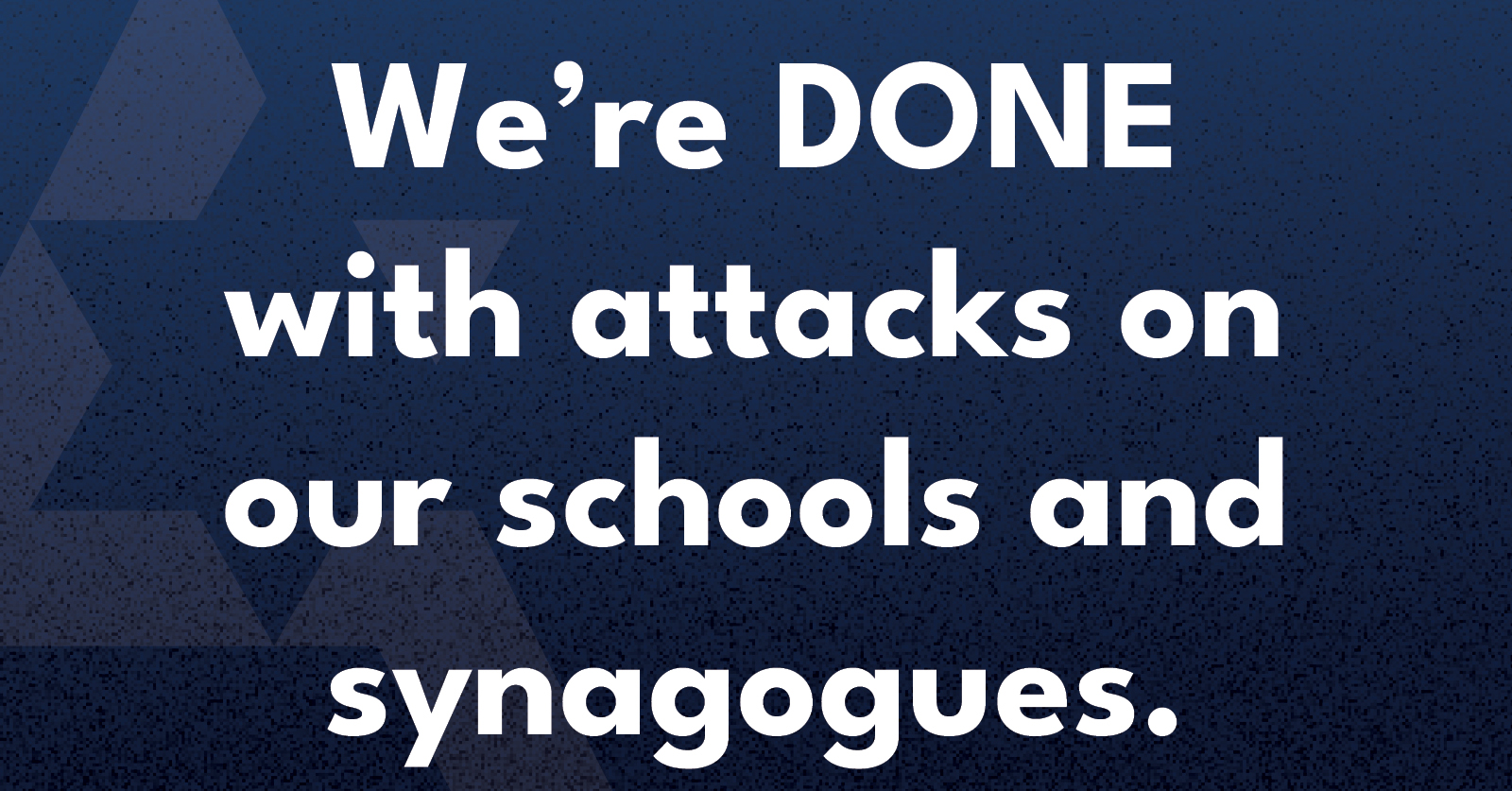Local News
Peretz School graduating class of ’63 subject of Atlantic Magazine profile

By MYRON LOVE Class reunions are most often a once (or twice)in a life time event. I myself have attended two smallish reunions of my Peretz School cohort as well as Aberdeen School’s 100th anniversary and St. Johns High School’s 75th and 100th anniversaries. While many welcome the opportunity to reconnect with former classmates – and others not so much – several members of the I.L. Peretz Folk School class of ’63 have in recent years made class reunions a regular happening.

Back row, standing, left to right: Bailey Rayter, Eric Posen, Lanny Silver, Harold Silverman, Mark Waintman, Ron Charach, Leslie Hatklin.
Middle row, left to right: Ethel (Levine) Kofsky, Bella (Sapoznik) Ben-Ari, Sharon Winokur, Ester (Schwartz) Kagan, Clara (Ross) Smukler, Barbara (Shoib) Murray z”l, Phyllis (Chrzan) Wollach.
Front row, seated, left to right: Annette (Feldman) Nagler z”l, Sharon Love, Sharen (Martin) Hogarth, Betty Eisenstadt, Janis (Swick) Wisher, Hilda (Szternfeld) Smith, Anita (Ladner) Bakal, Nettie Schwetz.
Our teacher Mrs. Brooks is on the left and Mr. P. Herstein, the principal, is standing on the right.

Top photo taken in Vancouver at the home of Bob and Reesa (Margolis) Devlin, August 2015, during our 65th birthday reuni
Seated, left to right: Leslie Hatklin, Brenda (Grushko) Casey, Arthur Itzkow, Ethel (Levine) Kofsky, Carol Pollock, Janis (Swick) Wisher, Gity (Shklarsky) Morris-Finkel, Candy Zell.
Standing, left to right: Ron Charach, Harold Abosh, Faigie (Raber) Samson, Earl Zimmer, Sharon Love, Lanny Silver, Myrna Shefrin, Bailey Rayter, Bella (Sapoznik) Ben-Ari, Reesa (Margolis) Devlin.
Now that bond that these former classmates have formed has been given international recognition in the pages of the prestigious Atlantic Monthly magazine. In the April 2 edition of the magazine, writer Julie Beck, under the aegis of her “Friendship Files” column, interviewed five of the classmates about their enduring friendship through the years. The five – Ron Charach, Reesa (Margolis) Devlin, Ethel (Levine) Kofsky, Sharon Love (my sister) and Bailey Rayter – reminisced about their elementary school days, growing up in Winnipeg’s Jewish community, the nature of their bonds over the years and how the reunions began.
As noted in the article, the first reunion was held 20 years ago to commemorate the 50th birthdays of the graduating class of ’63. Reesa Devlin, a former business owner and food writer, recalled that after she moved to Vancouver from Winnipeg – 25 years ago – she reconnected with some of her Peretz School classmates living there and they began to see each regularly. There were 14 of them living in Vancouver. It was the Vancouver group that organized the first reunion, which was held on the May long weekend in 2000. Since then, there have been three more reunions – alternating between Winnipeg (where the other large segment of the former classmates, including Love and Rayter, still live) and Vancouver – each commemorating milestones – either birthdays or other significant moments.
The second reunion, Sharon Love notes, took place in Vancouver over the November 11th, 2010 weekend, in celebration of the cohort’s 60th birthday. The third reunion was in Winnipeg in June 2013 – the 50th anniversary of their graduation from Peretz School. The fourth was back in Vancouver in August 2015, celebrating 65th birthdays. The last reunion was supposed to be last June in celebrating the 70th birthdays of the former classmates. That, however, was changed to a Zoom get together due to Covid restrictions.
Devlin noted in the article that the weekend reunions are replete with structured activities, including home dinners, some touring and a farewell brunch.
It was Ron Charach who got the ball rolling in regard to the Atlantic article. The Toronto-based psychiatrist and author (who was profiled in a recent Jewish Post & News column coinciding with the launch of his new children’ book) had written a lengthy non-fiction piece about the reunions, called “Elementary Reunion”.
“I got a reply from the editor of the Atlantic’s Family section saying she liked the idea but wanted one of her own writers (Julie Beck) to interview some of us,” Charach says. “I was asked to recommend four of my fellow students to join us in a joint interview.”
He chose Sharon Love because, he says, she has become the group’s unofficial historian (having written about the reunions in this newspaper). Bailey Rayter and Charach were best friends growing up. Reesa Devlin was one of the organizers from the Vancouver contingent. And Ethel Kofsky, Charach notes, added the perspective of being a child of Holocaust survivors.
Love reports that “the interview of us five talking lasted about an hour and a half. We did a lot of talking and, as a writer, she had to put together something that I am sure a lot of people can relate to”.
“Julie crafted a fine article,” Charach observes. “We were very happy about how it turned out.”
He adds that he is surprised at how many people have read the story. “This story has legs (in news media parlance),” he observes. “My daughter, for example, found out about it from a colleague at work.”
“We were fortunate that a special camaraderie developed within our group,” Bailey Rayter adds. “And it wasn’t just through our school ties. We saw each other a lot outside of school as well. Our lives were intertwined. We lived in the same neighbourhoods. We knew each other’s siblings. There were some family connections. We all went to the Y and many of us joined BBYO.”
As a psychologist, he points out that studies show that, particularly for boys, friendships we form can last a lifetime.
It is not so much a case of these former classmates having been lifelong best friends though, Charach points out. “After graduation, many of us went our separate ways. It is just that when you reconnect with former classmates there is a comfortable familiarity (similar to family) that you don’t share with friends who don’t go back that far.”
Local News
Cheryl Hirsch Katz, Jewish Child and Family Service’s longest serving staffer, set to retire at end of the month

By MYRON LOVE “I loved working at Jewish Child and Family Service,” says Cheryl Hirsh Katz, who is due to retire at the end of June. “I have always appreciated the warm and welcoming atmosphere here. I feel that the people working here are my extended family. I am going to miss my colleagues”.
“I have derived great satisfaction over the years to have been able to help many people in our community of all ages through my work at JCFS,” she continues.
After 44 years at the agency, Katz, the longest-serving member of the staff, was given an appreciative send-off at the JCFS’s recent (June 23) Annual General Meeting at the Shaarey Zedek Synagogue.
The daughter of Art and Bess Hirsh, Cheryl grew up in Garden City. She attended Peretz School, then Jefferson Junior High and Garden City Collegiate. She joined the staff of JCFS in 1981, shortly after receiving her Bachelor of Social Work degree.
She earned an MSW in 1990.
“I chose to become a social worker,” she recalls, “because I always wanted to be able to help people.”
Katz was originally hired by JCFS to work with newcomers. After a couple of years, she was given responsibility for looking after the needs of older adults.
“I really enjoyed working in older adult services,” she says. “That is where I spent the bulk of my time at JCFS.”
After ten years as a case worker, she was promoted to a supervisory role. Later, she was also given responsibility for mental health and addictions programming and settlement services, while keeping the older adult files under her purview.
“As a supervisor, I wasn’t directly involved with individual clients,” she points out. “I was more involved with programming. Among the programs for seniors we organized were – for example – sessions on elder abuse, digital storytelling and memory loss.”
She notes that one of the trends she has seen over the last 44 years is that people are living longer and living in their homes longer. A lot more of our clients are living well into their 90s,” she observes. “We have had to continually expand our staff and the services we provide in order to accommodate the growing demands of an aging population.”
She also spoke of the mental health needs of seniors and aging Holocaust survivors.
She says that she has mixed feelings about leaving JCFS. “After so many years working full time, I am going to have to create a new routine,” she comments.
She notes that, now that she is retired, she will have more time to spend with her parents – who are in their 90s.
And then, there are the two dogs to look after. “I will have time now to try new activities,” she says. “ I might learn to play mah-jong.”
She speaks about maybe doing some traveling – although her husband, Murray, is still working full time.
(She and Murray have one daughter, Farah.)
“Retirement may also include some volunteering,” she adds.
It is quite likely, she will be continuing her association with JCFS but in a volunteer capacity.
Local News
Gray Academy students shine in provincial, national debating competitions

By MYRON LOVE It has been another good year for Gray Academy’s high school students who participated in provincial and national debating competitions. The best results were recorded by Grade 9 student Noa Mednikov, who finished fourth overall nationally, fourth in interpretive reading, and fifth in persuasive speaking at the junior National Public Speaking Championship in early May in Vancouver.
Last October, in the Junior Provincial British Parliamentary Championship – which was held at St. John’s-Ravenscourt – Noa and her partner, Raya Braunstein, finished third as a team while Raya placed third in individual debating.
Their fellow Grade 9 student Maxim Moscalenkov tied for first in persuasive speaking in Vancouver, while the Gray Academy team of Gabe Tapper and Aaron Koplovich finished fifth. Aaron also finished fifth in his individual debate.
Earlier, in March, Maxim finished fifth in the Provincial Juniors debating competition, which was held at Balmoral Hall He and his debate partner, Nate Shenkarow, finished seventh among the teams entered. Last November, he and partner, Ethan Tenenbein, finished seventh in the Junior Prepared Tournament – just behind the Gray Academy team of Nate Shenkarow and Jack Kay.
At the senior high level in that competition, the team of Jacob Tenenbein and Jonah Novoseller finished fourth and Jacob was recognized as fifth best in an individual capacity. Jonah and Jacob also paired up to win the Asper Cup, which was held at their home school.
Jacob represented Manitoba at the Junior National Speech Championship in Vancouver in May and, last October, he and Grade 12 Gray Academy students Julie Krozkin and Daniel Bokser represented Canada at an international debating tournament in Bermuda.
Gray Academy’s debating program was introduced by Linda Martin in 2003. She also led the debating teams at Balmoral Hall. In 2011, Martin was succeeded by Gray Academy high school English teacher Andrew Kaplan.
“Andrew has done a wonderful job with the debating program” says Martin, who has a debating trophy at Gray Academy named in her honour, as well as a provincial trophy for best individual junior debater. “Over the years, Gray Academy students have done very well in many local, national and international competitions,” she adds.
About three weeks ago, this writer had the opportunity to sit down with Andrew Kaplan and six of the school’s top debaters while they discussed the benefits of learning how to debate. According to Noah Strauss – who competed in the Junior Provincials at Balmoral Hall in March, public speaking leaves him with a feeling of accomplishment.
“It’s a good skill set to have,” he observes. “It builds confidence.”
“A benefit of being able to debate is that you learn how to convince people that you know what you are talking about,” adds Maxim Moscolenkov.
Raya Braunstein notes that being able to debate is a skill that she expects to be helpful in many university courses which she may choose to take.
As Andrew Kaplan notes, the ability to express yourself has a great impact in whatever career you choose to pursue.
He points out that debating is compulsory at Gray Academy for all Grade 7 and 8 students – and students can continue debating as an option in the higher grades
Of course, competitive debating is not for everyone. For those students who opt to take that path, the journey begins with internal school debate competition – with the top debating teams and individuals qualifying for local tournaments and – potentially – beyond.
Andrew Kaplan reports that a small number of high schools in Winnipeg and southern Manitoba have active debating programs – including St. Johns Ravenscourt, St. Paul’s High School, St. Mary’s Academy, Garden City and Maples Collegiates in the Seven Oaks School Division, St. Maurice (a Catholic School), as well as Morden Collegiate and Dasmesh, a Sikh private school.
Kaplan expresses his appreciation to the Asper Foundation and an endowment spearheaded by the Kives Family for providing funding for the Gray Academy debating program – as well as the Andrew Slough Foundation – which was established by his friends in memory of the outstanding former Ravenscourt student debater and lawyer who passed away suddenly two years ago at the still young age of 38.
I am confident that our Jewish community can look forward to the continued success of Gray Academy’s star debaters and to the continual emergence of future stars as the times goes by.
Local News
Antisemitism has crept into grade school in Canada

Antisemitism in Canada has moved beyond protests and politics; it is now entering classrooms and altering how Jewish children see themselves functioning within them.
A a university student I have observed the experience of my younger brother in grade eight as a Jewish student. Over the past few months, his school has been at the center of several deeply troubling incidents that have made him feel unsafe in our parks, community, and even his school. Swastikas were drawn around the community, in parks and ponds. Additionally, an older man, who claims to be a pro-Palestinian influencer, stood outside his predominantly Jewish school wearing a keffiyeh, filming a video which then circulated between students on TikTok.
This same man later showed up to our local Jewish community center in keffiyeh to allegedly watch his son play basketball where my brother and many of his classmates go for their lessons, basketball games, and Jewish events. These moments made him and his peers feel watched and targeted just for being Jewish. Local political representatives condemned the incidents and raised awareness about antisemitism, but the fear among students didn’t go away. The feeling of being targeted for simply existing has been taught to my brother, something my parents had tried their hardest to escape from.
Most recently, my brother was chosen to represent his school at a regional science fair. When one of the judges arrived wearing a keffiyeh, he froze. For many, including my brother after the incidents he has faced, the keffiyeh represents a political message. But even more so for my younger brother, it is tied to the fear and intimidation he had already experienced. He felt nervous, distracted, and unsure of how to act.
This is not about silencing political expression. It is about a child who came to share his ideas and left feeling uncertain and afraid. It is about the atmosphere forming in Canadian schools, where Jewish students are being made to feel targeted and unwelcome.
His school made an effort to address the incidents, but the impact is lasting. Posts on social media, much can be very vague at times about inclusion cannot fully undo the feeling of being singled out. A kind word from a teacher does not erase the fear that builds when threats are left unspoken but deeply felt.
I am writing this as a sister who watched her younger brother lose a moment that should have been filled with confidence and pride. He deserved to feel safe. So do all Jewish students in this country.
Moving forward, schools must take concrete steps to protect all students. Antisemitism cannot only be addressed when it becomes violent or overt. It must also be recognized when it appears as intimidation, symbolic targeting, or political messaging that creates fear among students. Children should never have to question whether they are safe in their own classrooms or community spaces.
Events that are meant to support and celebrate students must remain focused on them. Individuals who feel the need to bring political symbols or messages into school grounds or children’s events should not be welcomed in those spaces. Schools must make it clear that their environments exist to support learning, safety, and inclusion, not to host agendas that can intimidate or isolate students.
Administrators and educators must develop clear guidelines for identifying and responding to antisemitic behavior in all its forms. This includes strengthening security measures, offering ongoing staff training, and engaging directly with Jewish families to understand their concerns. Inclusion is not a one-time statement. It is a responsibility that must be reflected in everyday decisions and actions. No child should ever feel unsafe or unwelcome because of their identity.
The author is a Campus Media Fellow with HonestReporting Canada and Allied Voices for Israel who lives in Toronto.
